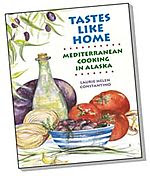
Tomato Tart captures the essence of vine-ripened tomatoes and is a lovely way to highlight their tangy sweet flavor. Mustard goes surprisingly well with garden tomatoes and fresh herbs, and a buttery crisp crust is the perfect platform to show them off. Everyone in the family agrees on these points.
There is vigorous debate, however, on how long to cook the tomatoes for the ideal tart. I like them best when they’re just warmed through, leaving the tomatoes hot, juicy, and full of fresh tomato flavor. My husband prefers them oven-roasted to concentrate their glorious summer sweetness.
Since we both like both versions, I usually make whatever I have time for. With lots of time, I make the oven-roasted tomato version; with less time, the slice and bake version. No matter the version, since tomatoes are front and center, use the best quality tomatoes you can find. During the summer tomato harvest, when juicy red tomatoes are easy to find, my thoughts always turn to Tomato Tart.
Flavor-rich Greek tomatoes inspired Tomato Tart. I first started making it in 1987 when we lived in Greece and were blessed with a garden glut of the best tomatoes I'd ever tasted. When we returned to Alaska, and were stuck with insipid supermarket tomatoes, this dish was out of reach. In recent years, however, tomatoes bursting with summer flavor have been showing up at Alaska farmers' markets. When they're available, Tomato Tart is on the menu.
In addition to the fresh/oven-roasted tomato variations, I’ve made Tomato Tart with regular Dijon mustard and whole-grain Dijon mustard. I’ve made it with the herbs called for in this recipe, as well as with fresh sage, fresh thyme, dried thyme, and various combinations of all or some of the herbs. I’ve made it with every kind of cheese imaginable. The constants are tomatoes, mustard, cheese, and herbs; the specifics depend solely on what’s in the refrigerator.
There’s a reason I’ve been making Tomato Tart for over 20 years. It’s delicious.

Tomato Tart with Buttery Crisp Crust (Fresh Tomato Version)
Serves 4 – 6 (One 10” tart)
Like pizza, Tomato Tart is delicious served cold. Mix the dough for the crust first; while it’s resting in the refrigerator, prepare remaining ingredients. Although it isn’t absolutely necessary to peel the tomatoes, for the fresh tomato version the finished dish has better texture if peeled tomatoes are used. To peel them, cut a shallow “X” on the bottom of the tomato. Drop the tomatoes in boiling water for 20 seconds. Remove the tomatoes and drop them in cold water. Drain and slip off the peels.
Crust:
1 1/2 cups all-purpose flour
1/4 tsp. salt
9 Tbsp. butter
1 egg yolk
2 - 3 Tbsp. ice water
Herb-Mustard Paste:
2 tsp. minced fresh rosemary
1 Tbsp. minced fresh basil
1 tsp. crushed dried oregano
2 cloves chopped fresh garlic
1-2 Tbsp. olive oil
Salt
Freshly ground black pepper
2 Tbsp. Dijon mustard
Filling:
Herb-Mustard Paste
1 1/2 cups coarsely grated graviera, asiago, Edam, or another good melting cheese
6-8 medium fresh ripe tomatoes (or 3 large), sliced 3/4” thick
Salt
Freshly ground black pepper
1/4 tsp. crushed dried oregano
Drizzle olive oil
Preheat oven to 425°F.
Make Crust: Whir flour and salt together in food processor. Cut butter into chunks, add to food processor, and pulse until butter is mostly combined with flour, but a few pea-sized pieces remain. (You can also cut butter into flour with two knives or a pastry blender.) Add egg yolk and 2 Tbsp. ice water and pulse to combine. If dough is too dry to hold together when pinched, add remaining 1 Tbsp. ice water and pulse. Dump dough out onto a piece of wax paper or plastic wrap and form into a solid disk. Wrap and refrigerate for 30-60 minutes.
Make Herb-Mustard Paste: Pound all ingredients for Paste together in mortar and pestle or combine well in a blender. (Start with 1 Tbsp. olive oil; add more as needed for smooth paste.)
Bake Crust: Roll out dough into 13 - 14” diameter circle. Center in 10” tart pan, pressing dough towards center and into edges. Trim overhanging dough so that it is size of the tart pan’s sides; fold over the overhanging dough to form a double-thickness side crust. Prick bottom of dough all over with a fork. Cut a piece of aluminum foil double the size of the tart pan, fold foil in half, and press it firmly into the dough (the foil prevents the dough from bubbling up while baking). Bake in preheated oven for 20 minutes. Remove foil and bake for 5 more minutes. Remove from oven.
Assemble Tart: Turn oven down to 400°F. Spread Herb-Mustard Paste over hot, prebaked crust. Evenly distribute grated cheese over mustard paste and top with sliced fresh tomatoes. Where necessary, cut tomato slices into pieces to fill in any gaps in tomato coverage. Lightly drizzle with olive oil, and sprinkle with salt, freshly ground black pepper, and crushed dried oregano. Bake for 20 minutes, until cheese is melted and tomatoes are just warmed through. Serve immediately.
Oven-Roasted Tomato Variation: Preheat oven to 400°F. Increase quantity of tomatoes by 4 medium or 2 large. Don’t peel tomatoes. Line 2 rimmed baking sheets with foil. Put tomato slices on baking sheets in single layer. Drizzle with olive oil and season with salt and freshly ground black pepper. Bake until tomatoes have dried slightly and the oil is browning on the foil around the tomatoes, but are still soft in the middle, about 45-60 minutes, depending on the tomatoes’ size. Remove from oven and cool on racks. Continue with recipe, as above.




















